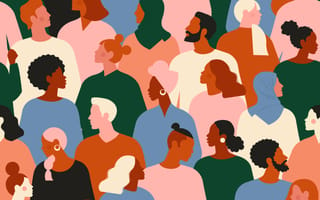In recent years, organizations have begun to take a closer look at identity and its influence on the workplace. After all, humans are complex creatures, and while there are many elements that unite us, there are perhaps just as many that differentiate us from each other.
While establishing employee resource groups and encouraging allyship are important, true change only takes place once organizations acknowledge the ways in which people and communities are impacted by their overlapping identities.
At Mural, a dedication to such intersectionality guides the company’s diversity, equity and inclusion (DE&I) efforts. According to the company’s vice president of talent, Yvette Kamperin, the visual collaboration platform provider has taken significant steps to create a more inclusive and equitable work environment, such as partnering with and investing in nonprofits committed to elevating individuals of all backgrounds.
In Kamperin’s mind, driving DE&I requires true team effort, which is why it’s important for every employee to feel empowered to participate.
“The most important thing is to elevate voices and create space for those often left unheard,” Kamperin said.
Built In San Francisco checked in with Kamperin to learn how the company approaches inclusion through an intersectional lens.
How does your company approach intersectionality in the workplace — particularly the intersection of race and other identities, such as sexual orientation, gender or parental status — and how does that help shape your broader DE&I initiatives?
Mural has experienced explosive growth over the past eight months, and while our gender population is 41 percent women and 50 percent men (with 9 percent preferring to not answer), we are in the process of understanding the overlapping nature of a person’s identity. We recognize that DE&I work focused on only one trait gives an incomplete view of our employees’ differences and can cause problems. For example, the work that has gone into advancing women in the workplace has disproportionately benefited white women. At Mural, we are actively sourcing underrepresented candidates to add to the top of the funnel. We partner and invest in nonprofits and platforms that help elevate people of color, ethnic minorities, LGBTQ+ community members, and differently-abled persons.
Earlier this year, we created a diversity, inclusion and belonging task force made up of volunteers who create events that draw awareness to multiple dimensions of identity and social systems that intersect with one another, such as parental status, sexual orientation and ethnic background, all of which we celebrate. This group kicked off an effort by our ERGs to help our employees gather with those who share the same passion or interests in a safe and inclusive workspace.

What has been the most impactful action your company has taken to create a more inclusive and equitable work environment for all employees, and why?
We’ve created an environment that welcomes and encourages conversation. With a globally distributed team, it is important to be able to come together and discuss difficult issues with trust and respect. This helps us set a thoughtful foundation for work going forward. Our product allows us to communicate and collaborate inclusively, as we provide an even playing field for quiet people who don’t normally speak up in a room. We are constantly coming up with new ways for our distributed teams to get to know each other and learn new things. We started implementing “power hours,” which are 45- to 60-minute sessions designed to power up your imagination. Whether you want to restore your energy, play a fast-paced game, learn something new in a workshop or give yourself a mindful moment, you’ll find something that suits your interests.
We’ve created an environment that welcomes and encourages conversation.”
What role do your employees play in driving DE&I efforts, and what have you done to ensure even the most marginalized voices on your team are represented, heard, valued and respected?
DE&I efforts do not fall under one person or team. For them to be truly successful, everyone needs to participate. The most important thing is to elevate voices and create space for those often left unheard. You can accomplish this with ERGs, conversation circles, research, education and allyship.
Muralistas — what we call our employees — kick off meetings using the platform to check in by doing a fun exercise that helps team members get to know each other outside of work. This helps us highlight both our differences and commonalities. We also started a learning session called “Culture Connection,” which allows our employees to share a bit of their own culture. Anyone can sign up to present or join in on the fun of learning about another culture.







